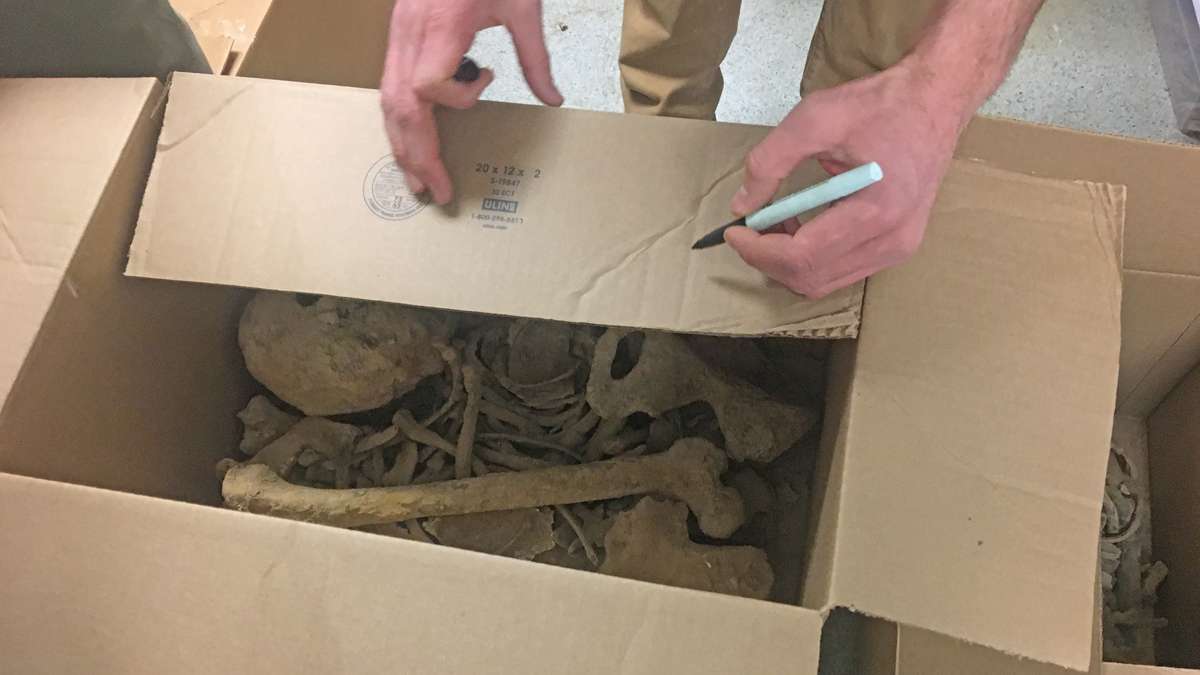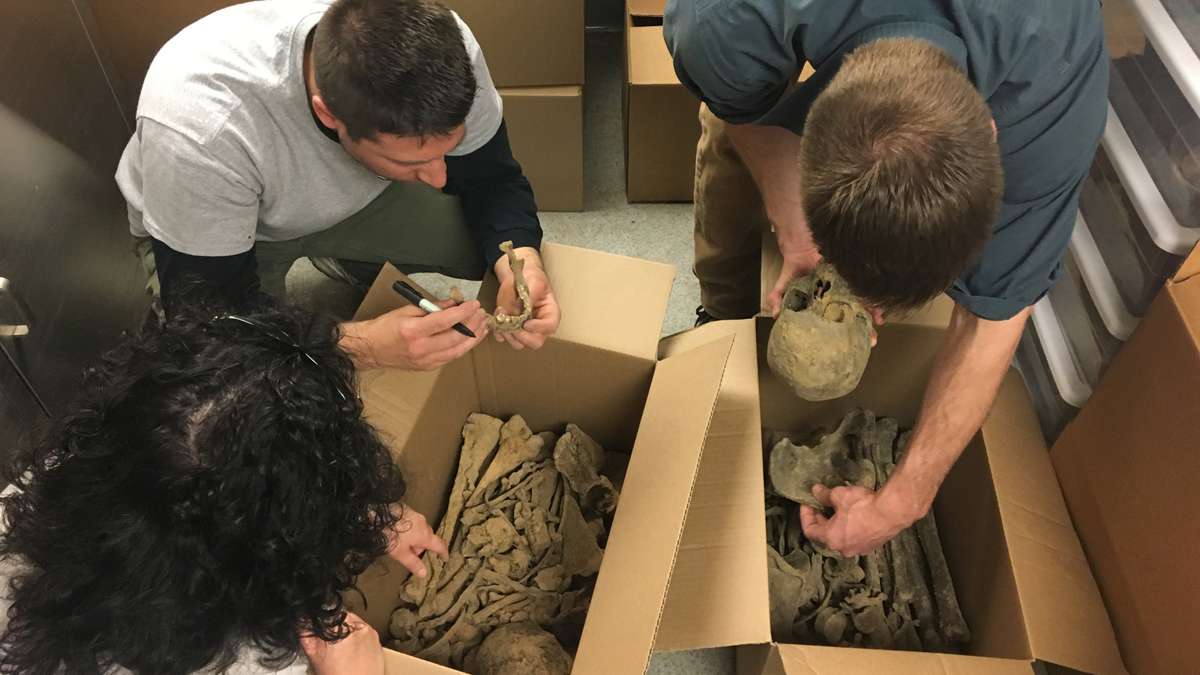Archaeologists embark on next phase of Arch Street excavation project [photos]
ListenKimberlee Moran says she got the call from the developer in February: we’re finding multiple bodies here. This is something we don’t know how to handle.
More bones believed to be part of one of Philadelphia’s oldest cemeteries had surfaced as workers on the private construction site at 218 Arch St. drilled deeper into the ground. The story started months earlier, when they unearthed just one box worth of unidentified remains.
The publicity and lack of oversight ignited concerns among preservationists and others on how public and private agencies should handle important remnants of the past. But, in the meantime, Moran and fellow archaeologists stepped in to help.
Now, she and others are trying to figure out how to properly handle the remains — and come up with the resources needed for next steps.
Moran, a forensic archaeologist at Rutgers-Camden, viewed that latest call from the developer as a unique chance to preserve and pay respect to some of Philadelphia’s oldest citizens.
PMC Property Group agreed to briefly halt work in mid-March, allowing Moran and motley crew of volunteer forensic specialists and archaeologists to sweep in, conducting an emergency dig to salvage what they could.
At the helm was Anna Dhody, a curator with the research arm of the Mutter Museum.
“It was crazy,” Dhody recalled. “It was ‘throw on some work clothes and get down there!'”
Excavating bones and other remains is familiar terrain for Dhody, who has a background in physical anthropology. She and others were grateful to have access to the private site, but they quickly found themselves in, well, way over their heads.
“So, the one week of proper excavation that we were doing, we removed 77 individuals, and they were a mixture of boxes and coffins,” said Moran.
In the scurry to get the remains safely stowed away, they wound up scattered among three locations. Some are at the Mutter; others are in Moran’s lab; and the rest are in a third-party storage unit that the developer helped coordinate in South Philadelphia.
This week, Dhody and Moran started the daunting task of tallying the array of remains at that last spot for the very first time since the dig. Notebooks and sharpies in hand, they took rough stock of the content of boxes, while counting and measuring coffins.
They were stressed but excited.
“My biggest concern is that these coffins have gone moldy,” Moran said.
“Now that the weather is getting warmer, it’s really imperative that we get them out,” Dhody said.
At first brush, everything appeared in good shape.
Still, the goal is to get the remains to a secure, centralized, temperature-controlled space. They recently learned The College of New Jersey has a spot, thanks to the involvement of archaeologist George Leader.
“I’m really excited about it because I think we have a great team here,” Leader said. “I think we’re going to find some really interesting things about Philadelphia and, ultimately, our nation’s history.”
Leader first met Dhody and Moran last month when he stopped by the site and basically jumped in to help. Now, about three weeks later, the group is facing new challenges; excavation was just the first step in gleaning details about these individuals.
Many of the remains are all mixed up in boxes that also hold unassociated bones.
The crew will have to go through them, taking meticulous notes to find clues.
On a more practical level, they need to figure out when and how to move the heavier, fragile coffins and how to pay for it.
“Imagine trying to move a piano that’s falling apart,” Moran said. “That’s the sort of situation we’re dealing with.”
This entire project is on top of their day jobs. Earlier this month, Dhody launched a crowdfunding campaign to raise money. The crew is looking into grant applications to do a proper analysis. Dhody wants the project to include a lot of public participation.
For its part, PMC Property group, said it put in tens of thousands of dollars toward helping with the dig.
“We were glad that we were able to assist with the process,” said Jonathan Stavin, PMC executive vice president. “And all of this was without any legal obligation on our behalf.”
After going through the necessary protocols, Stavin said, they’ll front the reinterment of the remains at Mount Moriah Cemetery in Southwest Philadelphia. That’s where the bodies were supposed to have been moved when the cemetery in Old City — First Baptist Church Cemetery — was relocated more than a century ago.
The entire handling of the Arch Street site is spurring local debates about how public and private agencies should handle these types of situations moving forward. Because in a city as old as Philadelphia, the tension between honoring the past and building the future will likely come up again.
The Pennsylvania Historical Commission, with the Philadelphia Archaeological Forum, is planning a public forum at the end of the month.
Looking ahead, Moran and others hope to create a field course in late spring, so students can help out and learn. They’re all curious about what these bones, with the help of some archival sleuthing, might reveal about Philadelphia’s forgotten past, about the experiences of these individuals and maybe even their actual identities.
They anticipate this next phase will be a lot of work, but Moran said she sees it as a responsibility.
“Ultimately we’re telling these people’s stories,” she said. “The stories were about to be lost, as they were essentially being destroyed in the process of construction. So it’s a wonderful opportunity to help these forgotten people to be remembered.”
WHYY is your source for fact-based, in-depth journalism and information. As a nonprofit organization, we rely on financial support from readers like you. Please give today.






